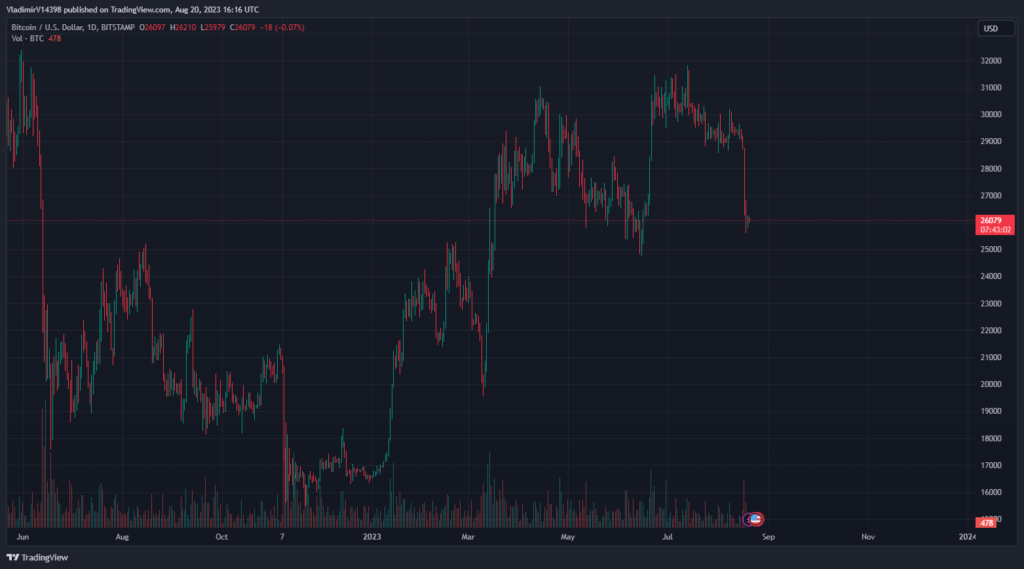Key Takeaways:
- Evergrande filed for Chapter 15 protection in the US.
- Its failure coincided with a Bitcoin market crash.
- Evergrande’s bankruptcy also raised concerns about Tether’s stability.
YEREVAN (CoinChapter.com) — On Aug 17, Evergrande, a China-based real estate giant, filed for Chapter 15 bankruptcy in Manhattan. Additionally, Evergrande’s affiliate, Tianji Holdings, went bankrupt, reigniting worries about China’s real estate market.
Interestingly, Bitcoin’s (BTC) price crashed 10% since Evergrande’s bankruptcy filing.
What Happened to Evergrande?
Evergrande owes $330 billion to its bondholders and other lenders. In addition, 40% of Chinese real estate companies have defaulted since mid-2021 — a bulk of them are private property developers. That has triggered a real estate crisis in China.
China Evergrande has just submitted a petition for Chapter 15 bankruptcy in New York, marking a significant move amidst its financial challenges.
No wonder Bitcoin is tanking like a rock today. Tether, which is what props up BTC and is likely heavily exposed to China…
— WhaleWire (@WhaleWire) August 17, 2023
However, Evergrande is planning to restructure. It has sought permission to raise $31.7 billion by selling dollar-denominated bonds. Evergrande will present itself to the court on Sep 20 and meet its creditors later in August.
China’s Real Estate Tumble Hits Bitcoin and Bros.
This burning question can find its answer to investor behavior in the wider financial markets. More specifically, Evergrande’s default and the subsequent economic loss pressured investors to cut involvement in Chinese real estate and focus more on safer options that exclude China.
For example, US hedge funds like Coatue, D1 Capital, and Tiger Global decreased their exposure to Chinese companies in the second quarter (Q2) of 2023. Even sharply, China-focused mutual funds suffered a net outflow of $674 million in Q2, per data provided by the platform Refinitiv.
This change in attitude created conditions where the crypto investment volume fell. And Evergrande’s bankruptcy played an indirect role in speeding up that loss of confidence in alternative assets. Bitcoin may have gotten caught in the crossfire of these economic developments.
Additionally, the US dollar has been performing better. As of Aug 22, the dollar index is 103 points, its peak performance in the last two months.

Plus that, Bitcoin’s and US dollars correlation index as of Aug 22, 2023, stands at the negative -0.63 mark. This correlation, in turn, can pressure Bitcoin’s price action.

The Bitcoin (BTC/USD) market took a hit, resulting in a 7% market shrinkage, even for a moment falling below the $26,000 mark. As of Aug 21, the price of Bitcoin is $26,013.
Moreover, at the time of the announcement, not only BTC got affected. For example, Ethereum contracted by nearly 6% in the same timeframe, while Ripple declined by 14%. Furthermore, Litecoin declined by 13%, and the meme coin Shiba Inu by over 8%.
Evergrande Also Creates Concern For Tether
Interestingly enough, Evergrande’s bankruptcy also touched Tether by creating concern for its stability and reliance on Chinese markets for said stability.
According to a mid-2021 report, Tether reserve backing comes from US dollar reserves and allegedly from Chinese commercial paper. However, the official Tether team assures that it currently doesn’t have any association with Evergrande’s or Chinese paper whatsoever.
Tether’s Ties to China

…seems a bit sketch to me
pic.twitter.com/FM8ri60aBx— Mr. Intuitive
Trumors Only. (@BlackberryXRP) August 16, 2023
Evergrande’s default creates concerns for the well-being of Tether and the general ties that Chinese companies have with crypto, more specifically, how these ties affect the ecosystem widely.
The Combined Factors Of The Crash
In essence, the woes of the Chiese real estate play their role in the crash. However, Evergrande’s default is probably not the sole reason behind the crash. For example, the sentiment toward Bitcoin was not in the best shape.
According to analysts at the on-chain analysis platform CryptoQuant, Bitcoin experienced negative funding rates, potentially making traders willing to short Bitcoin.
2/ US Demand
The sell off was preceded by a period of low #bitcoin demand in the US (negative Coinbase premium). pic.twitter.com/jfsOtLxWWD
— CryptoQuant.com (@cryptoquant_com) August 18, 2023
Moreover, they posit that low demand for Bitcoin in the US created conditions for the crash and the sell-off. In their on-chain vision, an increase in whale spending before and after the crash somewhat indicated it coming. This type of spending activity can intensify selling pressure.
Besides, analysts point out a general interest in shorting Bitcoin.
More specifically, to advance that goal by using open interest dynamics (Open interest refers to the total number of outstanding derivative contracts, such as futures or options contracts that have not yet been settled or closed).
The post Is China’s Evergrande Behind the Big Bitcoin Price Crash? appeared first on CoinChapter.







